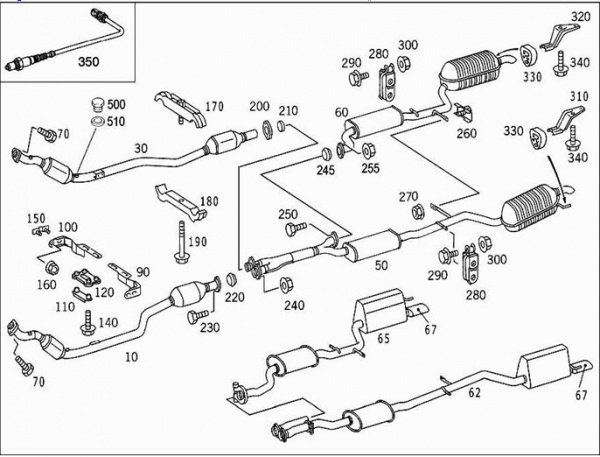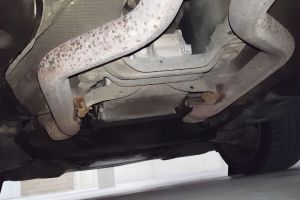Exhaust system
Description - Exhaust Pipes, Catalytic Converter, Mufflers


Issues - Exhaust Pipes, Catalytic Converter, Mufflers
- Occasionally the exhaust system will develop an annoying but quiet rattle. This may be a simple loose bracket, heat shield or clamp.
- Occasionally the exhaust system will develop an intermittent but very loud rattle. W220's are known to have an issue with the catalytic converters which come apart internally and make a loud rattling sound at particular engine speeds (around 2,500 RPM) and sometimes only when the cat is hot. You may not notice the noise when driving until the failure gets worse and the vibration gets very loud as it is masked by the usual road and car sounds. It is often first noticed when driving around a multi-level parking station where the sound bounces off the close solid walls. M-B issued an eight year / 80,000 mile (125,000 Km) warranty to cover the failed catalytic converters.
- Some owners have found that it is mostly the rear cats that fail, although be warned, it may be broken pieces in the front catalytic converter being deposited in a rear cat.
- The video shows a ML55 but is a good example of a noisy catalytic converter at idle speed.
- A catalytic converter can block sufficiently to reduce exhaust flow which may prevent the engine from developing full power. This issue will usually trip an engine fault code.
- Catalytic converters must not be disposed of as regular scrap. The catalytic converter contains valuable rare earth metals, which can be recycled.
Tips - Exhaust Pipes, Catalytic Converter, Mufflers
- Beware that often the rear cat will rattle because it is full of substrate that has broken down in the front cat and simply ended up in the rear cat.
- If replacing the catalytic converters with after market ones, go with a metal substrate catalytic converter since it will flow much better than a ceramic one.
- When reassembling a new or repaired exhaust system apply high temperature anti-seize copper grease to all the gaskets, seal rings, flange surfaces, and bolt threads. You will really appreciate having done this next time the system has to come apart.
- Also cover all exposed bolt threads with silicon to prevent corrosion. The silicon is easily peeled off before undoing the next time. If you have previously used the copper anti-seize grease you will be able to undo the nut by hand.
Parts - Exhaust Pipes, Catalytic Converter, Mufflers
- 210 Seal Ring Catalyst on Flange Right 1269970041 and 2024920181
- 220 Seal Ring Catalyst on Flange Left 140920281 and 202490281
- 245 Seal Ring Left to Right Pipe to Exhaust Pipe 2024920281 ie same as 220 Seal Ring Catalyst on Flange Left
- OEM catalytic converters cost around $1,200 but cheap aftermarket cats are available for under $300 installed.
DIY Procedures - Exhaust Pipes, Catalytic Converter, Mufflers
Diagnose Blocked Cat.
A good way to make sure a catalytic converter is not blocking is to perform a temperature test.
- Drive the car for say 20 Km to let the exhaust fully warm up.
- Put the car up on ramps or a hoist.
- Start the car and let it idle.
- Use a temperature probe or preferably an IR non-contact temperature sensor with laser pointer and measure the temperature of the exhaust pipe immediately before and after each catalytic converter.
- If the before and after temperatures are nearly the same the cat. it is not blocking.
- If the before and after temperature difference is large the cat. has an internal problem and is blocking.
Diagnose Source of Rattle Noise
- To investigate an annoying rattle jack the vehicle up and place on stands. (TIP: You may find that When you put the car up on front jack stands only, it will not rattle. One Benz-World enthusiast Had to level out the back of the car to get the rattle going.)
- Tap the complete exhaust system with a rubber mallet while listening for the rattle. If you are lucky it is often a broken strap or bracket making the noise. If you are unlucky you may have the dreaded internal issue common with the catalytic converters.
- If the rattle only appears at certain speeds, it is a loose baffle or interior part that is vibrating at its resonant frequency. To find this issue try tapping the rubber mallet at very quick intervals to get the vibration started.
- A mechanics stethoscope or even an ear listening against a long screwdriver handle can help find a quiet rattle.
Temporary Fix for Rattling Cat.
TIP: Be warned that any warranty will be void if there are dents found on the cats from someone trying to hold in the honeycomb substrate. Not a problem if you exceed the warranty period, but a caution for others with a newer vintage / class of car.
One enthusiast discovered a slight rattle coming from a rear cat. He took a hammer and put a little dent in the bottom of the cat to keep the internals from moving around and making noise.
He was lucky and the honeycomb material was still intact but had just come loose.
He reported after one year that the cats were still rattle free.
Some DIYers have hammered dents in three sides to secure the internals.
Permanent Fix for Rattling Cat. or Cat. Gutting
Be Warned: The material found inside a catalytic converter is toxic and appropriate handling precautions must be used.
Not recommended but a crude fix used by some DIYers for a rear rattling catalytic converter is to gut it. After the front and rear cat assembly is removed from the car, use a long piece of rod, pipe or crow bar to ram through the inside of the rear cat. Constantly shake out any broken pieces and progress slowly. It may take 30 minutes of probing and clearing out to remove most of the internals. Be careful not to distort the outer case or damage the pipes. Once the rear cat. is clear check the pipe between the front and the rear cats. as well.
An illustrated post at [1] by Benz-World member mercy-me shows how to gut a cat. by cutting it open and then sealing with a mechanically fastened metal plate.